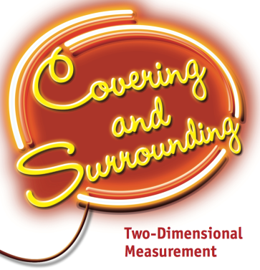Covering and Surrounding: Two Dimensional Measurement
Topics
Area and perimeter relationships, area and perimeter of polygons, surface area and volume of rectangular prisms.
Overview of Changes
Significant Changes: Circles are moved to 7th Grade to accommodate CCSS. Nets and volume of rectangular prisms are new in Investigation 4.
Detailed Description of Changes
In spirit and intention, this unit is the same as the CMP 2 version. Since the Common Core State Standards (CCSS) place the development of area and perimeter formulas for rectangles in 3rd and 4th grades, we have cut back on the development of these formulas in grade 6. However, the necessary understanding of area as a count of the number of square units needed to cover a surface and of perimeter as the count of the linear units needed to surround the surface are seldom solidified for students in one exposure. Consequently, we have provided a focused revisiting of the development of area and perimeter formulas for rectangles that can be used to assess students’ understanding developed in earlier grades and to deepen their understanding and skill in using these understandings in solving problems. The CCSS do not formally address area and perimeter in the 5th grade CCSS. Therefore it is important to revisit area and perimeter of rectangles and non-rectangular figures before developing strategies for finding the area and perimeter of triangles and parallelograms.
Since the area and circumference of circles is mentioned first in the 7th grade CCSS, we have moved the investigation of circles from Covering and Surrounding unit and placed it in the Filling and Wrapping unit. In 7th grade students find the area of the circle by using a transparent grid and counting the units needed to cover the circle. They also embed the circle in a square and compare the areas of the circle to the area of the square. The area of the square is the square of the diameter, d2 and the area of the circle is ≈3/4d2 or 3/4(2r)2 or πr2.If time permits, it makes sense to develop the area of a circle in this unit as a contrast to polygons. The teaching of area and perimeter of circles as an extension to polygons provides deeper understanding of each. It is the contrast between circles and polygons that reinforces and supports the understanding of both polygons and circles. Rectangles (squares) are also used to develop the area of a circle.
The 6th grade CCSS call for an investigation of nets made from triangles and rectangles that form rectangular prisms. This development is an appropriate follow-up to apply the area formulas for triangles and rectangles to prisms. As called for by the CCSS the volume of a rectangular prism is revisited using fractional side lengths. Since the formulas for volume of rectangular prisms were developed in 4th and 5th grade, the development here is a brief review. More extensive work with volume of prisms, cylinders, cones and spheres is done in 7th grade and again revisited in 8th grade in Say It With Symbols.
| New Investigation | Changes in CMP2 Investigation |
|---|---|
| Investigation 1 Designing Bumper Cars: Extending and Building on Area and Perimeter | Investigation 1 is a condensed version of Investigations 1 and 2 in the CMP2 |
| Investigation 2 Measuring Triangles | Investigation 2 is similar to Investigation 3 in CMP2 |
| Investigation 3 Measuring Parallelograms | Investigation 3 is similar to Investigation 4 in CMP2 |
| Investigation 4 Measuring Surface Area and Volume | Investigation 4 is new to accommodate CCSSM. Surface area is a natural extension of area of polygons which are discussed earlier in this unit. |
